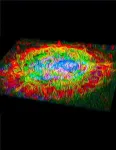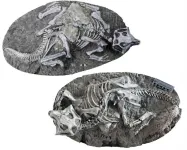(Press-News.org) **EMBARGOED FOR RELEASE UNTIL NOV. 4 AT 3:00 P.M. EST**
A new study from researchers at Wilmer Eye Institute, Johns Hopkins Medicine explains not only why some patients with wet age-related macular degeneration (or “wet” AMD) fail to have vision improvement with treatment, but also how an experimental drug could be used with existing wet AMD treatments to save vision.
Wet AMD, one of two kinds of AMD, is a progressive eye condition caused by an overgrowth of blood vessels in the retina, the light-sensing tissue in the eye that also relays vision signals to the brain. Such blood vessels — caused by an overexpression of a protein known as VEGF that leads to blood vessel growth —then leak fluid or bleed and damage the retina, causing vision loss.
Despite the severe vision loss often experienced by people with wet AMD, less than half of patients treated with monthly eye injections, known as anti-VEGF therapies, show any major vision improvements. Additionally, for those who do benefit with improved vision, most will lose those gains over time.
Now, in the full report published the week of November 4 in the Proceedings of the National Academy of Sciences, the Wilmer-led team of researchers share how such anti-VEGF therapies may actually contribute to lack of vision improvements by triggering the overexpression of a second protein. Known as ANGPTL4, the protein is similar to VEGF, as it can also stimulate overproduction of abnormal blood vessels in the retina.
“We have previously reported that ANGPTL4 was increased in patients who did not respond well to anti-VEGF treatment,” says Akrit Sodhi, M.D., Ph.D., corresponding author and associate professor of ophthalmology and the Branna and Irving Sisenwein Professor of Ophthalmology at the Johns Hopkins University School of Medicine and the Wilmer Eye Institute. “What we saw in this paper was a paradoxical increase of ANGPTL4 in patients that received anti-VEGF injections – the anti-VEGF therapy itself turned on expression of this protein.”
The team compared VEGF and ANGPTL4 levels in the eye fluid of 52 patients with wet AMD at various stages of anti-VEGF treatment. Prior to anti-VEGF injections, patients with wet AMD had high levels of ANGPTL4 and VEGF proteins. After treatment, their VEGF levels predictably decreased, yet ANGPTL4 levels rose higher, indicating ANGPTL4 remained active following the anti-VEGF injections and the treatments contributed to an increase in ANGPTL4. Such ANGPTL4 activity can lead to blood vessel overgrowth and lack of vision improvement.
The team then investigated ways to bridge the gap between patients with increased ANGPTL4 following anti-VEGF treatments by testing the experimental drug 32-134D in mice with wet AMD. The drug decreases levels of a third protein, HIF-1, known to be involved in wet AMD and diabetic eye disease for its role in switching on VEGF production. Researchers believed the HIF-inhibitor 32-134D would have a similar effect on ANGPTL4 following anti-VEGF treatment, since ANGPTL4 production is also turned on by HIF-1.
In mice treated with 32-134D, the team observed a decrease in HIF-1 levels and VEGF, as well as decreased levels of ANGPTL4 and blood vessel overgrowth. Mice treated only with anti-VEGF therapies corroborated the team’s findings in human patients: levels of VEGF were lower, yet ANGPTL4 levels rose, preventing anti-VEGF therapies from fully working to prevent blood vessel growth (and vision loss). Researchers also determined that combining 32-134D with anti-VEGF treatments prevented the increase in HIF-1, VEGF and ANGPTL4. This treatment combination was more effective than either drug alone, showing promise for treating wet AMD.
“This work exposes a way to improve anti-VEGF therapy for all patients and potentially help a subset of patients with wet AMD who still lose vision over time despite treatment,” Sodhi says. “Our hope is that this [project] will further the three goals we have related to wet AMD: make current therapies as effective as possible, identify new therapies, and prevent people from ever getting wet AMD.”
The study’s other authors include Deepti Sharma, Evan Lau, Yu Qin, Murilo Rodrigues, Chuanyu Guo, Emma McIntyre, Shaima Salman, Yousang Hwang, and Gregg L. Semenza of Johns Hopkins University School of Medicine; Aumreetam Dinabandhu and Silvia Montaner of the University of Maryland; and Ala Moshiri at the University of California Davis. Aumreetam Dinabandhu and Yu Qin also have affiliations with the Johns Hopkins University School of Medicine and the Eye Hospital of China Medical University, respectively.
This work was supported by the National Institutes of Health grants R01EY029750, R01EY032104, EY001765 (the Wilmer Core Grant for Vision Research, Microscopy and Imaging Core Module); the TEDCO Maryland Innovation Initiative; the Research to Prevent Blindness, Inc., Special Scholar Award, the Sybil B. Harrington Stein Innovation Award, and an unrestricted grant to the Wilmer Eye Institute, Johns Hopkins School of Medicine; the Armstrong Family Foundation; the C. Michael Armstrong Professorship and research funding from the Armstrong Family Foundation; and the Branna and Irving Sisenwein Professorship in Ophthalmology. The funding organizations had no role in the design or conduct of this research. Akrit Sodhi and Gregg L. Semenza are co-founders of and hold equity in HIF Therapeutics, Inc. Shaima Salman, Yousang Hwang, Akrit Sodhi and Gregg L. Semenza are inventors on provisional patent application PCT/US2022/039883. This arrangement has been reviewed and approved by the Johns Hopkins University in accordance with its conflict of interest policies.
END
Scientists determine why some patients don’t respond well to wet macular degeneration treatment, show how new experimental drug can bridge gap
2024-11-04
ELSE PRESS RELEASES FROM THIS DATE:
Did the world's best-preserved dinosaurs really die in 'Pompeii-type' events?
2024-11-04
Between about 120 million and 130 million years ago, during the age of dinosaurs, temperate forests and lakes hosted a lively ecosystem in what is now northeast China. Diverse fossils from that time remained pretty much undisturbed until the 1980s, when villagers started finding exceptionally preserved creatures, which fetched high prices from collectors and museums. This started a fossil gold rush. Both locals and scientists have now dug so much, their work can be seen from space―perhaps the most extensive paleontological excavations anywhere.
By the 1990s, it was clear that the so-called Yixian ...
Not the usual suspects: Novel genetic basis of pest resistance to biotech crops
2024-11-04
If left unchecked, insect pests can devastate crops. To minimize damage and reduce the need for insecticide sprays, crops have been genetically engineered to produce bacterial proteins that kill key pests but are not harmful to people or wildlife. However, widespread planting of such transgenic crops has led to rapid adaptation by some pests. A new study in the Proceedings of the National Academy of Sciences reveals a novel genetic basis of resistance to transgenic crops in one of the most important crop pests in the United States.
Researchers from the University of Arizona Department of Entomology in the College of Agriculture, Life and Environmental Sciences used genomics to investigate the ...
Jill Tarter to receive Inaugural Tarter Award for Innovation in the search for life beyond earth
2024-11-04
Jill Tarter to Receive Inaugural Tarter Award for Innovation in the Search for Life Beyond Earth
November 4, 2024, Mountain View, CA – Renowned astronomer, Dr. Jill Tarter, SETI Institute co-founder and pioneering SETI researcher, will be honored with the inaugural Tarter Award for Innovation in the Search for Life Beyond Earth at the SETI Institute’s 40th Anniversary celebration on November 20, 2024, in Menlo Park, CA. This new award recognizes individuals whose projects or ideas significantly advance humanity’s search for extraterrestrial life and intelligence. The Tarter Award honors contributions ...
Survey finds continued declines in HIV clinician workforce
2024-11-04
November 4, 2024 — The supply of healthcare professionals available to provide HIV care continues to decline, even as the need for HIV care and prevention is expected to increase, reports a survey study in the November/December issue of The Journal of the Association of Nurses in AIDS Care (JANAC). The official journal of the Association of Nurses in AIDS Care, JANAC is published in the Lippincott portfolio by Wolters Kluwer.
"Our study provides new insights into the numbers and characteristics of clinicians who will be available to provide HIV care in the coming years. This information ...
Researchers home in on tumor vulnerabilities to improve odds of treating glioblastoma
2024-11-04
A team led by researchers at the University of Toronto has uncovered new targets that could be the key to effectively treating glioblastoma, a lethal type of brain cancer. These targets were identified through a screen for genetic vulnerabilities in patient-derived cancer stem cells that represent the variability found in tumours.
Glioblastoma is the most common type of brain cancer in adults. It is also the most challenging to treat due to the resistance of glioblastoma cancer stem cells, from which tumours grow, to therapy. Cancer stem cells that survive after a tumour is treated go on to form new tumours that do not respond to further treatment.
“Glioblastoma tumors have ...
Awareness of lung cancer screening remains low
2024-11-04
There is a lung cancer screening test that is saving lives – and yet most people who could be getting the test have never heard of it or never talked about it with a doctor.
“We’ve got a screening test that works. It works as well, if not better, than breast and colorectal cancer screening in terms of mortality reduction. It's one of the most life-saving things we have for a cancer that kills more people than either of those two combined,” said lung cancer pulmonologist Gerard Silvestri, M.D. And yet, he said, “Eighty percent of those eligible for this screening, regardless of race, education, ethnicity, health or income, hadn’t heard of or ...
Hospital COVID-19 burden and adverse event rates
2024-11-04
About The Study: In this cohort study of hospital admissions among Medicare patients during the COVID-19 pandemic, greater hospital COVID-19 burden was associated with an increased risk of in-hospital adverse effects among both patients with and without COVID-19. These results illustrate the need for greater hospital resilience and surge capacity to prevent declines in patient safety during surges in demand.
Corresponding Author: To contact the corresponding author, Mark L. Metersky, MD, email metersky@uchc.edu.
To access the embargoed study: Visit our For The Media website at this link https://media.jamanetwork.com/
(doi:10.1001/jamanetworkopen.2024.42936)
Editor’s ...
NSF NOIRLab astronomers discover the fastest-feeding black hole in the early universe
2024-11-04
Supermassive black holes exist at the center of most galaxies, and modern telescopes continue to observe them at surprisingly early times in the Universe’s evolution. It’s difficult to understand how these black holes were able to grow so big so rapidly. But with the discovery of a low-mass supermassive black hole feasting on material at an extreme rate, seen just 1.5 billion years after the Big Bang, astronomers now have valuable new insights into the mechanisms of rapidly growing black holes in the early Universe.
LID-568 was discovered ...
Translational science reviews—a new JAMA review
2024-11-04
About The Article: To help clinicians keep up with ongoing basic and translational science discoveries that affect the diagnosis and treatment of human disease, JAMA has launched a new series, “Translational Science Reviews.” These new article types are succinct and informative summaries of important basic science advances that are transforming diagnosis and treatment of human disease.
Corresponding Author: To contact the corresponding author, Mary M. McDermott, MD, email mdm608@northwestern.edu.
To access the embargoed study: Visit our For The Media website at this link https://media.jamanetwork.com/
(doi:10.1001/jama.2024.21146)
Editor’s Note: Please ...
How the keto diet could one day treat autoimmune disorders
2024-11-04
Scientists have long suspected the keto diet might be able to calm an overactive immune system and help some people with diseases like multiple sclerosis.
Now, they have reason to believe it could be true.
Scientists at UC San Francisco have discovered that the diet makes the gut and its microbes produce two factors that attenuated symptoms of MS in mice.
If the study translates to humans, it points toward a new way of treating MS and other autoimmune disorders with supplements.
The keto diet severely restricts carbohydrate-rich ...






